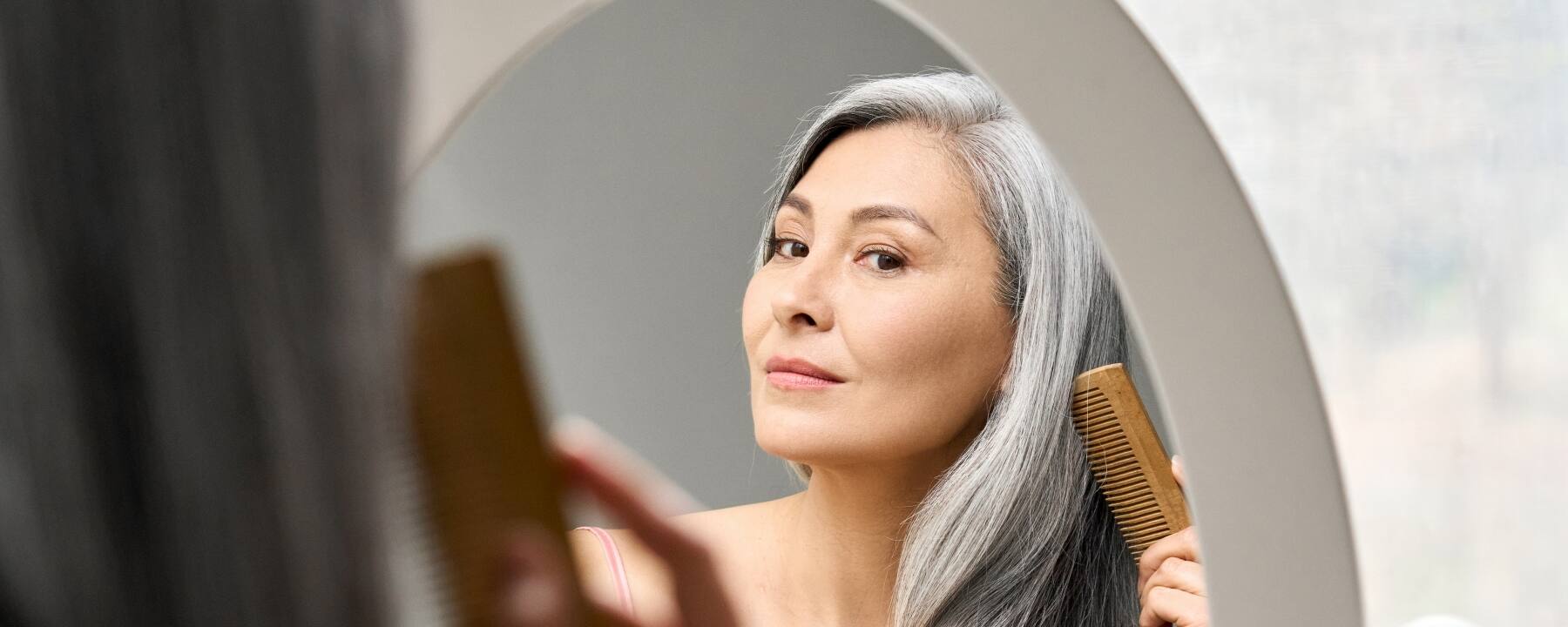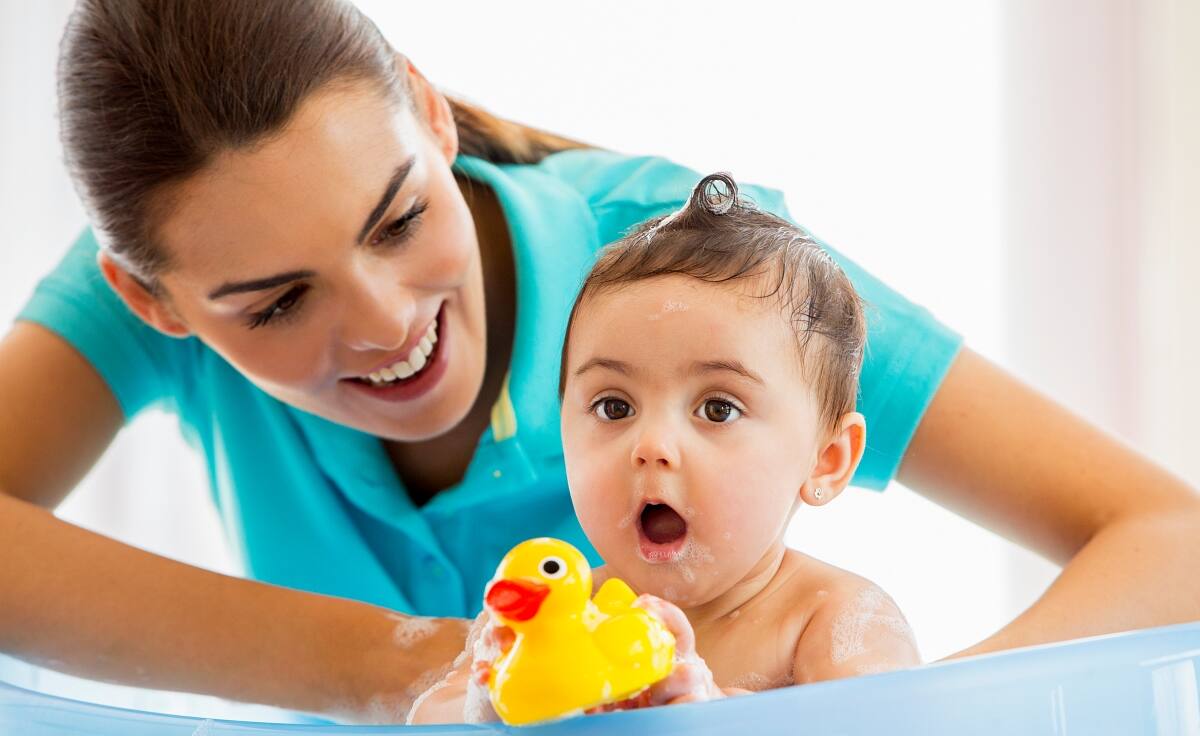
Well aging
Menopause, skin and hair
Menopause. Admittedly a complex and still sensitive topic. Why do we want to write about it here? Because this period of change in a woman’s life also affects her skin and her hair.
“You’re reaching that time of life.” Over the course of our life, we hear this phrase quite often – but it can evoke entirely different reactions and feelings depending on when we hear it. As a teenager in puberty, for example, it is a reason to look forward. We look forward to what is about to happen, what we can now do that we couldn't before, and the doors that will open for us. For people over the age of 40 and women entering or already at the menopause, the statement is more likely to elicit the feeling of “Oh no, I’m getting old.”
But being old really doesn't have to be negative. And to eradicate the fear of being “old” for all women, we'd like to quote film legend Audrey Hepburn:
The beauty of a woman is not in the clothes she wears, the figure that she carries, or the way she combs her hair. True beauty in a woman is reflected in her soul. The beauty of a woman only grows with passing years.-
Movie legend Audrey Hepburn
It doesn't get much more positive than that when looking forward the future and a new phase of life, does it?
A new phase of life The menopause is by no means a disease or illness, yet despite representing the start of a new phase of life, it causes considerable physical and psychological problems for many women. Common menopausal symptoms include:
- Hot flushes
- Sleep disorders
- Mood swings/depression
- Loss of libido
- Weight gain
- A decrease in bone density
- Muscle and joint pain
- Cardiac arrhythmia
- Thyroid problems
Hormones are responsible for all of this. The word is derived from the Greek: hormon – setting in motion, driving, stimulating. Hormones are the messengers generated within the human body to control and regulate the body’s own metabolism, circulation and salt and water balance. In short, hormones are the messengers of life. Virtually all organs react to hormones through their receptors, as well as to changes in the concentration of hormones.
From a medical point of view, the menopause can be divided into three time periods or phases:
Perimenopause
The perimenopause, or premenopausal period, which marks the start of menopause. Hormone production slows down and menstrual cycles become more irregular. On average, the perimenopause starts during the mid to late 40s. It can last between three and seven years. However, it varies hugely from one woman to the next.
Menopause
Menopause means the last menstrual period. The ovaries stop producing eggs and the woman can no longer become pregnant. Menopause is confirmed once a woman has not had a period for more than 12 months. Most women experience menopause around the age of 51-52.
Postmenopause
Postmenopause is the last phase of menopause, starting 12 months after the final period. For some women, various menopause-related complaints subside or are no longer as pronounced and fade away.
Their main role in relation to the menopause involves the estrogens, the female sex hormones. Due to a drop in estrogen concentrations or levels, hormones and cells communicate differently during menopause, meaning the body and organs first have to learn to adapt to this. There is also an imbalance between estrogen and androgens (such as testosterone), i.e. between the female and male hormones, as women also produce androgens. This can be a somewhat turbulent time for both body and mind. It is almost a kind of second puberty.
The menopause is a time of change. The fact that these changes do not take place evenly or smoothly, but rather in a constant series of ups and downs and highs and lows, does not make things any easier. The only constant during the menopause is that nothing is constant nor remains the same.
Does that all sound depressing to you? It doesn't have to be, because this difficult phase does pass. And, in fact, many women experience only a few mild symptoms – some none at all. Aging is part of life and the most natural thing in the world. What matters is the attitude we adopt towards it. There are also good reasons to look forward positively to the future. Many women report that their quality of life actually improves. They are happier and some are more liberated. Above all, their self-confidence is right back where it should be.
Not the starting point for skin aging
Many of the symptoms mentioned are not visible. However, the change in hormone levels has a clear visible effect on some women. And this brings us to the subject of skin and hair. To touch on the fear of aging again: the menopause is many things, but it is not the starting point for visible skin aging. Our skin shows the first signs of aging at around age 25, and you should expect the first visible changes to occur then. But here's a twist: aging actually starts before we're even born. And everything we do to our skin in our younger years becomes visible later on. Back then, did you worry about becoming old? Rarely, we'd guess.
The reasons for aging are diverse, and the extent and course of aging are highly individual. But nobody is spared. It starts with small laughter lines or crow’s feet, usually at the outer edge of the eyes. Our facial expressions are responsible for the first lines on our foreheads.
What starts as a delicate, barely noticeable process becomes very noticeable as the years go by: our wrinkles become deeper, longer and there are more of them. Other signs include the skin and lips becoming dry, age spots becoming visible, and the nasolabial fold becoming more pronounced.
The menopause affects the skin – loss is a major issue
Many people desire a beautiful skin – meaning a healthy color, no wrinkles and no flaws. It is not only the body's largest organ, but also the structural part that is in direct contact with the environment. It performs many functions and provides a protective layer against environmental influences. Not only that, but we and other people see it.
Interesting facts about skin
Everything here revolves around the right care for your skin. In this article, we'd like to give you a few interesting facts: things that you don't necessarily need to know, but which may still surprise you or leave an impression.
More informationDuring menopause, the skin loses both volume and elasticity. The result: our skin becomes slacker and loses its contours. Elasticity and strength decrease significantly from around age 50, when the menopause causes hormonal changes. The skin is no longer able to retain moisture so well and its barrier continuously weakens. At this stage, the skin’s ability to neutralize free radicals decreases. This is of major significance in terms of skin aging.
It dries out quickly and reacts rapidly to irritation and sensitivity. This can result in an increase in red patches. Gravity can also make itself felt as the skin starts to sag. Cellulite may now become visible. In addition to the visible skin, the mucous membranes in the mouth, nose and genital areas are also affected by the changes.
What happens, exactly? Let’s look at the natural changes across the three different layers of the skin: the epidermis, the dermis and the hypodermis.
- Epidermis
The skin's barrier function reduces, cell metabolism slows down, and the production of lipids and ceramides decreases. The epidermis decreases in thickness and the stratum corneum retains less water. The skin becomes drier and rougher. Other consequences include more uneven pigmentation, reduced protection from UV rays, increased susceptibility to infection and poorer healing of wounds. - Dermis
Aging weakens the elastic fibers and collagen. Overall, the amounts of collagen and elastin in the skin are reduced. In the first five years after menopause, there may be a reduction of up to 30%. Crosslinking also becomes more irregular. The boundary layer to the epidermis flattens out. The dermis begins to atrophy. As a result, the skin loses some of its stability and elasticity. Its capacity to retain water also decreases. - Hypodermis
The number and size of fat cells decrease, leading to more loss of volume. All the visible signs of aging are magnified.
Hair can thin out
Our relationship with our hair is one of continual coming and going. Although you lose around 70 to 100 hairs a day as a result of completely natural hair loss, around 85-90% of all the existing hair on a person is in its growth phase at any one time. This level of hair loss has no impact on your appearance because you simply don't notice it. The hair shaft, the visible part of the hair, keeps us looking good.
From a scientific point of view, hair is part of the skin. Biologists use the somewhat unwieldy term of adnexa, or “skin appendages” to describe it. The nails on our fingers and toes are also skin appendages. And yes, you guessed it. The condition of your hair can also change during the menopause. It becomes thinner, may change color and often become more fragile.
During menopause, women have to contend with numerous health issues. Hair loss may be one of them. The scientific term for this: androgenetic alopecia (hormonal and hereditary). Major hormonal changes cause estrogen levels to decrease and the level of male hormones to increase, resulting in thinner hair and hair loss. This happens because the hair cycle changes, the growth phase is shortened, and the hair grows more slowly. This is another mental stress factor for those women who are affected. This hair cannot be expected to "grow back” later.
The power of estrogen
During pregnancy too, the condition of your hair and how it grows will change. Due to the increase in your estrogen level, more hairs than usual will enter the growth phase, resulting in hair that is thicker than normal. However, this is reversed after giving birth and the temporarily thicker hair thins out again. In most cases, the hair loss is really only temporary. A similar phenomenon occurs after women stop taking the pill. In this situation too, their hair count changes.
Stress factors for hair
Sometimes it’s like you're just jinxed. You do everything you can to look good, you have a hairstyle you want to try, but you know straight away that it will be too much for your hair.
More informationAnother contributing factor to hair issues: keratins. These proteins, which are responsible for the hair's special and extraordinary properties, are affected by and become partially damaged by the stress factors mentioned above. As a result, the hair loses its tensile strength, its elasticity and shine. This can also create split ends.
Thankfully, there are suitable products available to care for the hair and support its various functions – from both inside and out. While some care substances (e.g. cationic surfactants and polymers, proteins, cosmetic oils) can protect against hair damage and deploy their effects on the hair's surface and the cuticle layer, so-called "microproteins" are often applied in shampoos and conditioners. These microproteins penetrate the hair and strengthen it from within.
Care in many areas
Balanced care is important to counteract unwanted effects. Look after yourself with the right mix of care, exercise and nutrition. Proper nutrition for skin & hair and maintenance of the skin’s natural pH (5.5) are both crucial.
By the way, it is very likely that your previous – perhaps much-loved – care products will no longer work, or will no longer be suitable, due to all the changes at work in your body. A change is recommended and makes a lot of sense in many respects given your new requirements.
With your hair's “new” fragility, you should be even more careful when using styling devices such as straighteners, hood dryers, curling tongs, hairdryers, combs and brushes, and minimize the stress they cause to your hair. Caring for the roots of your hair is extremely important.
Think positive
When dealing with your skin and using peeling masks, it is important they are mild and gentle to avoid stressing the surface of the skin too much. Any further skin irritation should be avoided. As is so often the case, there is no one-size-fits-all solution, so listen to your skin and do what feels good.
Most importantly: think positive, keep your spirits up and try to avoid stress. Stress can quickly lead to a vicious cycle by causing further (skin & hair) problems. While the menopause certainly has its drawbacks, do you want to let it defeat you? Definitely not.
You don't need to be afraid of getting old; you just have to look forward to what’s coming next. Remember what we said at the beginning, and think of it as a second puberty. In any case, it's going to be quite the trip. We'll wrap up now with Astrid Lindgren: “There's nothing in the Ten Commandments that forbids old ladies to climb trees, is there?"


